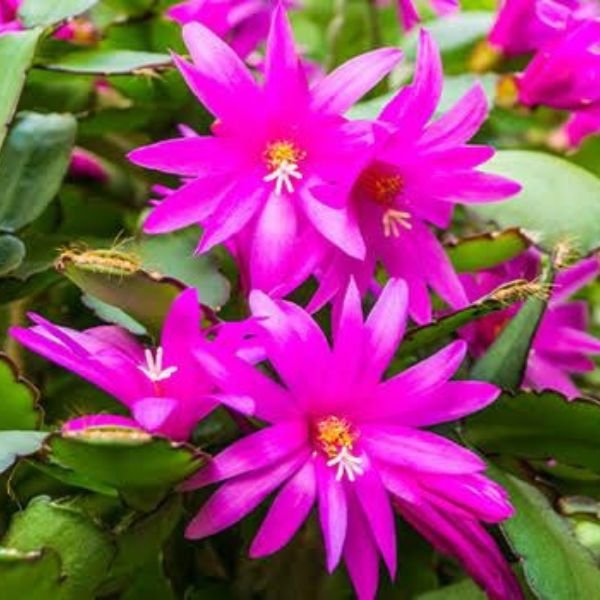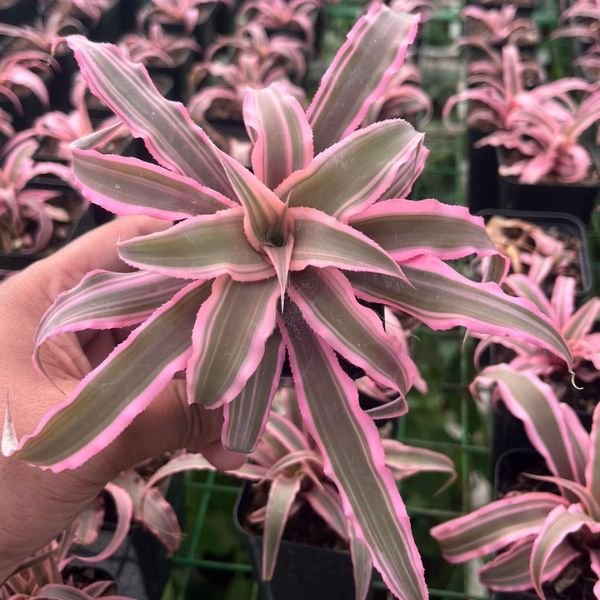Rhynchostylis orchids are a type of tropical plant that produces stunning waxy flowers in a long and elegant inflorescence. These plants are native to Southeast Asia, Myanmar, and Thailand and grow on trees as epiphytes. They feature long, dark green leaves and have a unique and consistent fragrance that is present throughout the genus, regardless of the season in which the species blooms. Several common names describe Rhynchostylis orchids, including Saccolabium albolineatum, Giant Rhynchostylis, Anota Gigantea, and Gastrochilus giganteus. The genus name itself, Rhynchostylis, comes from the Greek words \”rhynchos\” meaning \”beak\” and \”stylis\” meaning \”column.\” This name refers to the distinctive beak-shaped column present in the type species of this orchid Rhynchostylis orchids produce sprays of small flowers in cream, red, lavender, or blue colors and share similarities with Vanda orchids. These plants are relatively easy to grow in small pots but require a bit of maintenance to thrive. There are two popular varieties of Rhynchostylis orchids: Rhynchostylis Retusa and Rhynchostylis gigantea. In addition to those, there are other types of Rhynchostylis orchids such as Rhynchostylis coelestis and Rhynchostylis rieferi, but for now, let\’s focus on the two most popular ones.
Rhynchostylis Retusa
Rhynchostylis Retusa known as foxtail orchids boast show-stopping aesthetics with its elegant flower spikes. The plant features hanging flower spikes with densely-packed pink and white blooms arranged in a slender, narrowing inflorescence that can grow up to 15 inches in height. This plant\’s striking appearance, coupled with its delightful scent, makes it a top choice for both indoor and outdoor gardens. Rhynchostylis Retusa is easily propagated through seed germination or by separating an adult plant\’s rootstock or stem cuttings. Additionally, it is a low-maintenance plant that can thrive in small pots. These magnificent blooms of Rhynchostylis Retusa can be seen during the spring season.
Rhynchostylis Gigantea
Rhynchostylis gigantea with a spicy fragrance is well-known among horticulturalists. This orchid species can grow up to 25 inches tall, while its counterpart, Rhynchostylis Retusa, has a long flower cluster. You can cultivate Rhynchostylis gigantea easily, provided you give it the appropriate growing conditions. Lindley, a notable botanist, made a detailed description of this orchid species. One of its distinctive features is the absence of pseudobulbs, with thick roots and dark green leaves instead. The blooms of Rhynchostylis gigantea are also noteworthy, as they can last up to two weeks during January and February. The Giant Rhynchostylis captivates gardeners and flower enthusiasts alike with its clustered flower arrangement. These sweetly fragrant blooms come in a range of colors, including red, purple, and white, some even featuring spotted designs.
Other Rhynchostylis Varieties
To enter into the deep world of Rhynchostylis orchids, knowing two distinct types of wild and hybrid Rhynchostylis orchids is crucial. They can be found in forests and jungles where they grow on trees or rocks. These orchids are not only easy to grow, but they also possess a unique exotic beauty. One of the rare and stunning wild Rhynchostylis orchids is the Rhynchostylis retusa, which is known as the \”foxtail orchid\” due to its dense bushy inflorescence. In spring or winter, the clustering bunch of more than 100 white and pink flowers on this plant look mesmerizing.
Aside from wild orchids, our nursery offers a variety of hybrid Rhynchostylis orchids. The process of hybridization creates them, where two different species of orchids are crossbred to produce a new variet Hybrid Rhynchostylis orchids include the Rhynchostylis Creamy Orchid, which features creamy orange flowers, and the Hybrid Rhynchostylis Moon White Orchid, which has large white flowers with a moon-like appearance. The other species, Rhynchostylis Pink Blue has delicate pink and blue flowers, while the Rhynchostylis Red Orchid has bright red flowers that stand out against its green foliage. Lastly, the Rhynchostylis Spot Cartoon Orchid has a white body adorned with maroon flower spots. All of these flowers emit a delicate, sweet fragrance that adds to their beauty.
Temperature
Rhynchostylis orchids thrive in warm and humid environments since they are epiphytic plants. They have a broad range of temperature tolerance, but they can\’t survive in frosty conditions. Maintain a daytime temperature of 22°C to 30°C, with a slight drop of 5-8°C at night, for optimal growth.
Lighting
Rhynchostylis orchids require specific lighting conditions for optimal growth and blooming. When planted outdoors, it\’s important to provide them with partial shade rather than direct sunlight. Indoors, placing them near a south or southeast-facing window with bright but indirect light is ideal. A minimum of 8 hours of sunlight each day is necessary for these orchids to bloom properly. Failure to provide sufficient lighting can result in a lack of blooming.
Watering
For the healthy of Rhynchostylis orchids, proper watering is a crucial factor. Overwatering can cause the potting medium to become waterlogged, leading to root rot. In humid conditions, it\’s important to maintain moist soil, and misting can help achieve this. During the growing stage, frequent watering is necessary to keep the potting medium moist. However, if the plants have enough water, it\’s not necessary to water them further. The frequency of watering should be based on the potting medium and may range from once to twice per week.
Fertilization
Fertilizing Rhynchostylis orchids is essential for promoting the growth and blooming of Rhynchostylis orchids. The frequency of fertilization should be based on the specific species of orchid and done during the second to fourth watering. You can apply a balanced NPK fertilizer with a ratio of 20-20-20 or 30-10-10, or a high-nitrogen or phosphorus fertilizer at ¼ strength, once a week during the growing season. In winter, fertilization once a month is sufficient. These orchids require more frequent fertilization during the growing period than during the resting period. However, it\’s not necessary to fertilize them during the resting period, as it won\’t harm the plants.
Humidity
Rhynchostylis orchids prefer high-humidity areas. They thrive in humid conditions with good air circulation. Ideally, the humidity levels should be around 70% to 80% to promote optimal growth. A location with good air circulation and optimal humidity is the best way to grow these orchids. In cases where humidity is lacking, misting and placing a humidity tray filled with water and pebbles near the orchids can be helpful.
Blooming
Rhynchostylis orchids bloom during the winter to the spring season, typically around January to February. Adequate lighting is a crucial factor in promoting blooming in these orchids. Depending on the species of Rhynchostylis, the flowers can last for a minimum of two weeks to a longer period. These orchids come in a wide range of colored blooms, with many varieties and shapes and a mesmerizing scent.
Potting, Medium and Repotting
Rhynchostylis orchids should be planted in small clay or hanging pots that have a good drainage system. Orchid growers pot these orchids in a medium of bark or moss, with perlite or charcoal as additional options. When planting or moving your Rhynchostylis orchids to a new pot, it is important to carefully handle their roots and use soil that allows excess water to drain away easily. Repotting is only necessary if the plant outgrows the size of the container or if there are severe diseases. Avoid frequent repotting, but it\’s okay to repot if the potting medium becomes old or the pot breaks.







